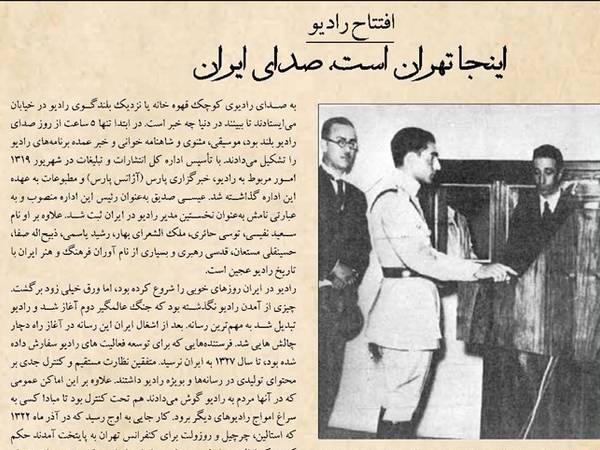Radio Iran, the state-run radio turned 85 on April 23. Once a driving force of Iran's modernization, the broadcaster transformed into an Islamic propaganda tool following the 1979 revolution.
When the 'national radio' was introduced in Iran in 1939, there was an abundance of print media in the country. However, nearly 80 percent of the population was illiterate and unable to engage with the politically diverse media landscape. Radio emerged as a platform accessible to all, providing a means for engaging with the nation.
For four decades, Radio Iran served as a platform for the monarchy, promoting Shah Mohammad Reza Pahlavi's "positive nationalism" rhetoric. It also aided the country's technocrats in advancing a robust development plan, supported by the 1949 US-sponsored Point Four plan. This initiative, hailed by Washington as "a bold new program," aimed to leverage US scientific and industrial advancements for the growth and development of underdeveloped regions.
Radio Iran started its programming with news and entertainment for a few hours a day with the national hymn being broadcast at the beginning and end of daily programs. The hymn's starting lyric "Long live the Sha!" was indicative of the radio's political slant although leftist intellectuals and non-militant Islamists had their own share of the radio's limited airtime.
Radio Iran's biggest contribution to Iran's development, particularly in the 1950s, and 1960s was its advocacy of elements of progress including literacy, industrial and agricultural modernization, family planning and public education about concepts such as women's liberty and emancipation. The radio also advocated liberal ideas about political participation and the rights of workers and farmers.
During the 1950s and 1960s, as Radio Iran expanded to 24/7 programming, it embraced the ideals of the United Nations for a better future for humanity. One notable program, "Let's Make the World a Better Place for All," exemplified this vision. The radio aimed to connect Iranians with the global community, emphasizing their role in a rapidly progressing world. Live broadcasts of events like the Olympics and milestones such as satellite launches underscored this effort to keep Iranians abreast of global developments.
Meanwhile, without succumbing to the influence of Muslim extremists, the radio aired religious programs during the Islamic holy months of Muharram and Ramadan, spotlighting key Shiite religious events. Additionally, a prominent cleric, Hossein Ali Rashed, hosted a highly popular hour-long primetime program every Thursday, attracting millions of listeners across Iran.
Perhaps more significant than all other programs from the 1950s to the late 1970s, was a three-hour long daily women's program every morning from 8:30 to 11:30, which offered more than cooking, public health and home economics points. The program "Woman and Life" hosted by renowned female celebrities such as Moloud Atefi, Forouzandeh Arbabi and Sorour Mahneshan played a key part in introducing the idea of women's equality with men. The idea was conveyed so delicately that it faced no objection from the traditional segments of the population.
At night, the radio showcased Iran's finest classical and pop music, along with the latest hits from the US and Europe. Afternoon hosts engaged listeners with discussions over tea. A program titled "Of Everything, Everywhere, Everybody" provided practical public knowledge interspersed with popular songs.
The news programs, while consistently beginning with coverage of the Shah, remained relatively impartial and politically balanced, free from ideological bias. Current affairs segments permitted moderate criticism of the system's deficiencies. Additionally, content from Tehran's outspoken press was incorporated into radio broadcasts without fear of reprisal for broadcasters, writers, or presenters. It was a regulated media landscape, characterized by limited control rather than totalitarianism, allowing for certain civil and social liberties.
The 1979 Islamic revolution wrought profound changes in Iran, including a radical transformation of the national radio. Overnight, women singers vanished from the airwaves, replaced by mournful songs depicting early Islamic tragedies. Female presenters became scarce, smiles were banned on TV, and radio content rendered women nearly invisible. Yet, this state of affairs was unsustainable.
It wasn't until nearly a decade later that women began to reappear in news and children's programs. In the late 1980s and early 1990s, a brief window for criticism opened in the morning program "Hello, Good Morning," but dissent was swiftly stifled as the regime grew intolerant.
Since 1979, Radio Iran has remained deeply ideological, adhering strictly to the government's official narrative, even in accounts of Islamic history. The station's disregard for public taste has alienated listeners, with many turning to foreign-based media for news. State broadcaster research acknowledges declining viewership for state TV but remains silent on the radio's fate.
Listeners are not to blame for Radio Iran's decline, as repetitive ideological propaganda fails to engage or inform. Recent TV programs have featured celebrities confessing to favoring old songs over state radio broadcasts. Despite this, podcasts have emerged as a vibrant alternative, offering diverse content free from censorship. One such podcast, "Radio Nist" ("It's Not Radio"), explores Iran's radio history, including an episode titled "Radio Ark," named after Tehran's Ark Square, home to Radio Iran's former studios.
